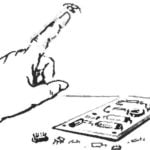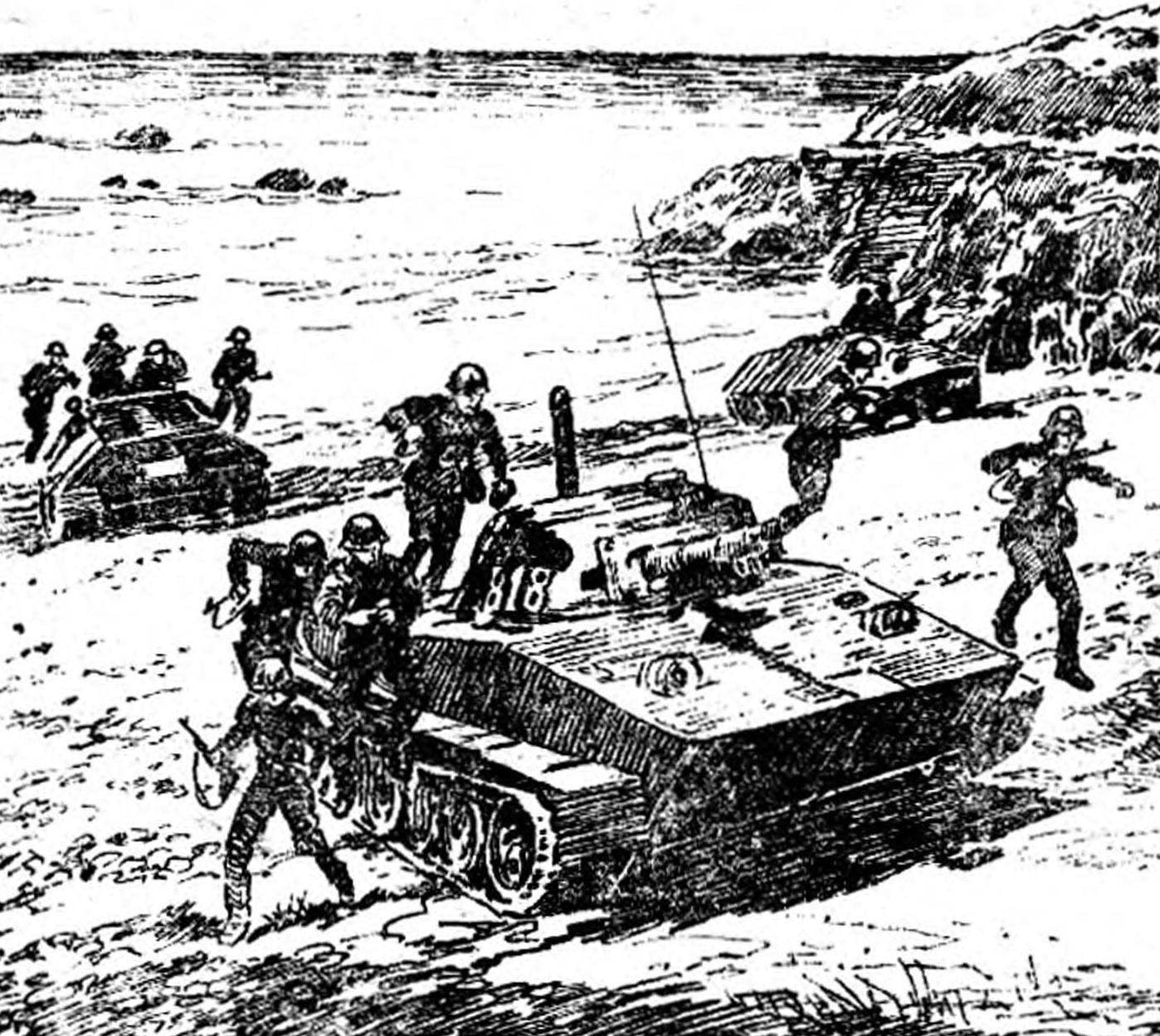The tank units, mechanisms, ammunition located so that the center of gravity as low as possible: this is necessary to enhance stability. Derived from the equilibrium sea wave or close burst of a shell, the tank quickly regains a stable position. A hermetically sealed housing and sealing turret allow amphibians to get in the water with large pitch, roll, swim in heavy seas, and navigation equipment enables to make significant transitions sea.
The armament of the PT-76 is much superior to the previous samples of the floating technique. He is armed with a powerful 76-mm gun D-56ТМ and coupled with it machine gun 7.62 mm. Ammunition gun consists of 40 unitary shots and the machine gun attached 1 thousand rounds in belts. Armament supplemented by one AKM assault rifles, 15 grenades f-1 and 20 rounds for the flare gun.
Fire from guns and afloat, despite the fact that the turret at this time, tighten the seal. With the remote control commander, who is also the gunner, gives the driver a command to change the angle of movement of the tank relative to the target. In the vertical plane of the gun is in the usual way.
Water-jet propulsion tank PT-76:
1 — output camera, 2 — vodoprodazhnaya pipe, 3 — drive mechanism, 4 — pump 5 — suction inlet, 6 protective grille, 7 — tank, 8 — pump 9 — inlet guide vane, 10 — nozzles rear, 11 — nozzle.
Tracks: with a crest (top) and without comb.
Powerplant amphibians — diesel engine V-6 rated at 240 HP provides the movement with a maximum speed of 46 km/h on land and 10.2 km/h on the water. Engines-2 medium tanks of the previous editions has been double, a V-6 under the same Carter had one block six the same as that In 2 cylinders. Power train consists of a traditional five-speed gear box used in sneakers, T-34, of steering clutches and two internal gears that transmit rotational force to the cannons, allowing them to be used together with the caterpillars separately. The exhaust device of the engine is protected against the ingress of water into the cylinders when the engine is stopped. Provided the system is pumping water that has penetrated into the body.
Engine smoke generator (TDA) is used to create a smokescreen length of 300-400 m. the commander and the driver have night vision devices. In the daytime the crew is monitored by a periscopic devices.
In case of fire in case of combat damage in a tank is fitted with fire fighting equipment. With the appearance of smoke and flames in the engine compartment, the signal from the sensors actuates a control mechanism cylinders with carbonic acid. Possible and manual control of the system.
The tank is not terrible roads, wetlands and snow. With a weight of 14 tons specific pressure is only 0.5 kg/cm2. Even the illustrious thirty-four it was half as much.
The second modification of the tank PT-76B — you’ll be installing a two-axis stabilised pointing gun D-56ТС, allowing to fire on the move. Conditions length crew members in a tank is improved by the application on the barrel of the gun ejector, suction powder gases from the gun barrel after firing. The mode of operation of the sliding-rolling devices is improved by the introduction of the muzzle brake with an effective braking.
PT-76 with the image of the naval flag on the turret can be seen on all the fleets of our country. No doctrine of the marine corps is not complete without these light machines, confidently handled from one wave to another. One after another they come out with the ramps of the landing ships into the water and the first wave of Marines coming to shore, firing from cannons and machine guns. Behind main battle tanks in armor and armament, they are ahead of them in mobility when crossing water obstacles, open the way to land on the shore of medium and heavy tanks, lead Marines, destroying artillery fire tracks of fire of the enemy, destroying engineered barriers, capturing the best lines of defense and their starting POSITIONS for the offensive.
TIPS ON MODELING
Accurate reproduction of the external details of the hull and turret greatly increases the resemblance to the original. In front of the tank on the armor have two headlights, covered with gratings. The driver’s hatch is equipped with three observation devices. Tow hooks are arranged on the lower inclined armor plate sheet.
In the rear of the hull at the left side of the air inlet grille and diffuser of the ejector. The first is painted the same color as the body, the second — black.
On the tower top — headlight in black, on the body — protective. Gun can be equipped with a muzzle brake.
Road wheels have black rubber tires. The maximum number of trucks in caterpillar — 96. The tracks within the track of two types — with ridges and without them. Fenders, front and rear rubber mud flaps.
On the turret of a tank of white paint is applied to a three-digit fleet number and a symbol or part of a compound. Tanks belonging to the marine units, the tower is depicted as a naval flag.
Recommend to read
 MAGNETIC FINGER…
MAGNETIC FINGER…
I think many who have to work with small metal objects. will be useful to my "magnetic" finger, or rather — rubber fingerstall to which is glued a small square of a permanent magnet. “HOME DRILLING RIG”
“HOME DRILLING RIG”
Having a plot of land for a vegetable garden in our climate zone, regular watering is necessary to get a good harvest. But in the absence of your own water well or a well, at the...
 Few people of Leningrad, occupancies that August day in 1935, near the Peter and Paul fortress, the Neva river, witnessed the unusual spectacle. On the river, confidently slicing through low, the wave, floated… tanks. Here all seven turned sharply to the shore, and a few minutes of armored amphibians were already on the sand. Thus ended a 600-kilometer test transition amphibious tanks T-37 on the rivers Luga, Shelon, lake Ilmen and further along the new Ladoga canal and the Neva river.
Few people of Leningrad, occupancies that August day in 1935, near the Peter and Paul fortress, the Neva river, witnessed the unusual spectacle. On the river, confidently slicing through low, the wave, floated… tanks. Here all seven turned sharply to the shore, and a few minutes of armored amphibians were already on the sand. Thus ended a 600-kilometer test transition amphibious tanks T-37 on the rivers Luga, Shelon, lake Ilmen and further along the new Ladoga canal and the Neva river.